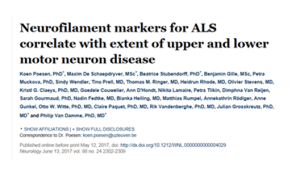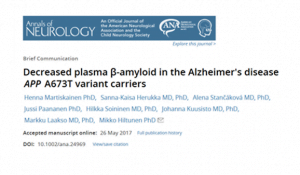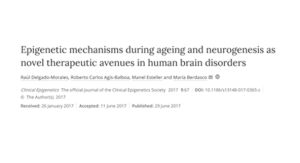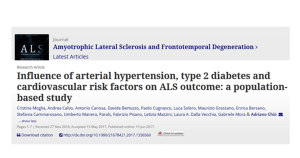 “Does participation in the Meeting Centre Support Programme change the stigma experienced by people with dementia?” has been published in the journal European Psychiatry. This work was supported by JPND through the MEETINGDEM project, selected in the 2012 Healthcare Evaluation call.
“Does participation in the Meeting Centre Support Programme change the stigma experienced by people with dementia?” has been published in the journal European Psychiatry. This work was supported by JPND through the MEETINGDEM project, selected in the 2012 Healthcare Evaluation call.
Yearly Archives: 2017
In experiments with a protein called Ephexin5 that appears to be elevated in the brain cells of Alzheimer’s disease patients and mouse models of the disease, researchers show that removing it prevents animals from developing Alzheimer’s characteristic memory losses. In a report on the studies, published in The Journal of Clinical Investigation, the researchers say the findings could eventually advance the development of drugs that target Ephexin5 to prevent or treat symptoms of the disorder.
Curious about whether Ephexin5 — a protein regulated by the protein EphB2 and thought to be responsible for inhibiting the development of dendritic spines — might play an important role in Alzheimer’s disease symptoms, researchers first investigated whether this protein might be poorly regulated in Alzheimer’s animal models and patients.
The researchers discovered that when they added amyloid beta to healthy mouse brain cells growing in petri dishes, these cells began overproducing Ephexin5. Additionally, when they injected the brains of healthy mice with amyloid beta, cells there also began overproducing Ephexin5 — both clues that the protein that makes Alzheimer’s characteristic plaques appears to trigger an increase in brain cells’ production of Ephexin5 of between 1- and 2.5-fold.
When the researchers examined preserved brain tissues isolated from Alzheimer’s patients during autopsies, they also found similarly high levels of Ephexin5. Additionally, they found elevated levels of Ephexin5 in mice genetically engineered to overproduce amyloid beta, and that show memory deficits similar to those with human Alzheimer’s disease, further confirming that excess Ephexin5 is associated with this disease.
Armed with what they called this wealth of evidence that brain cells produce too much Ephexin5 when Alzheimer’s disease linked to amyloid beta is present, the researchers then investigated whether reducing Ephexin5 might prevent Alzheimer’s deficits.
Using genetic engineering techniques that knocked out the gene that makes Ephexin5, the researchers developed mouse Alzheimer’s disease models whose brain cells could not produce the protein. Although the animals still developed the characteristic Alzheimer’s amyloid plaques, they didn’t lose excitatory synapses, retaining the same number as healthy animals as they aged.
To see whether this retention of excitatory synapses in turn affected behavior related to memory tasks, the researchers trained healthy mice, mouse models of Alzheimer’s and Alzheimer’s models genetically engineered to lack Ephexin5 in two learning tasks: one that involved the ability to distinguish objects that had moved upon subsequent visits to the same chamber, and another that involved the ability to avoid chambers where they’d previously received a small electric shock.
While the typical Alzheimer’s disease model mice appeared unable to remember the moved objects or the shocks, the Alzheimer’s animals genetically engineered to be Ephexin5-free performed as well as healthy animals on the two tasks.
The researchers caution that while the results all suggest removing Ephexin5 prevented Alzheimer’s disease-associated impairments, they don’t on their own provide a true test for the approach to treatment. That’s because in people with Alzheimer’s disease, the brain is exposed to amyloid beta for some time, probably decades, before any treatments might be administered.
To better reflect that human scenario, the researchers raised mouse models for Alzheimer’s disease into adulthood — allowing their brains to be exposed to excess amyloid beta for weeks — before injecting their brains with a short piece of genetic material that shut down Ephexin5 production. These mice performed just as well on the memory tasks as the healthy mice and those genetically engineered to produce no Ephexin5.
Together, these results suggest that too much Ephexin5 triggered by amyloid beta and reduced EphB2 signaling might be the reason why Alzheimer’s disease patients gradually lose their excitatory synapses, leading to memory loss — and that shutting down Ephexin5 production could slow or halt the disease.
Paper: “Reducing expression of synapse-restricting protein Ephexin5 ameliorates Alzheimer’s-like impairment in mice”
Reprinted from materials provided by Johns Hopkins Medicine.
 “Neurofilament markers for ALS correlate with extent of upper and lower motor neuron disease” has been published in the journal Neurology. This work was supported in part by JPND through the STRENGTH and RiMod-FTD projects, selected in the 2012 Risk Factors call.
“Neurofilament markers for ALS correlate with extent of upper and lower motor neuron disease” has been published in the journal Neurology. This work was supported in part by JPND through the STRENGTH and RiMod-FTD projects, selected in the 2012 Risk Factors call.
For the first time, a variant in UBQLN4 gene has been associated with amyotrophic lateral sclerosis (ALS; also known as Lou Gehrig’s disease) – a progressive disease resulting in the loss of nerve cells that control muscle movement, which eventually leads to paralysis and death. The study, published in the journal eLife, also describes how this gene variant disrupts a cellular process that drives motor neuron development. This new insight opens the door to potential treatment targets for ALS.
The earlier discovery of mutations in UBQLN2 gene, which causes ALS and ALS/dementia, led to the screening of the UBQLN family of genes in a large cohort of patients with familial ALS, resulting in the identification of the UBQLN4 mutation.
Using a zebrafish model, researchers were able to reverse the defects caused by the UBQLN4 gene variant by inhibiting the beta catenin signaling pathway with the drug quercetin. These findings suggest that this pathway could be targeted for treatment. More research will be needed before a similar drug could be shown to work in people with ALS.
The researchers say that, at present, they don’t know how common the UBQLN4 gene variant is among people with ALS, so making this determination will be an important focus for future research.
Paper: “A novel ALS-associated variant in UBQLN4 regulates motor axon morphogenesis”
Reprinted from materials provided by the Ann & Robert H. Lurie Children’s Hospital of Chicago.
Researchers have, for the first time, revealed the atomic structures of one of the two types of the abnormal filaments which lead to Alzheimer’s disease. Understanding the structures of these filaments will be key in developing drugs to prevent their formation.
The researchers, whose study is published today in Nature, believe the structures they have uncovered could also suggest how tau protein may form different filaments in other neurodegenerative diseases.
Alzheimer’s, the most common neurodegenerative disease, is characterised by the existence of two types of abnormal ‘amyloid’ forms of protein which form lesions in the brain. Tau forms filaments inside nerve cells and amyloid-beta forms filaments outside cells. Tau lesions appear to have a stronger correlation to the loss of cognitive ability in patients with the disease.
Almost thirty years ago, scientists identified tau protein as an integral component of the lesions found in Alzheimer’s and a range of other neurodegenerative diseases. But, until now, scientists have been unable to identify the atomic structure of the filaments.
The researchers extracted tau filaments from the brain of a patient who had died with Alzheimer’s disease. The filaments were then imaged using cryo-electron microscopy (cryo-EM). The researchers developed new software in order to calculate the structure of the filaments in sufficient detail to deduce the arrangement of the atoms inside them.
The researchers say that their study could lead to the development of new approaches to the diagnosis and treatment of Alzheimer’s disease.
Paper: “Cryo-EM structures of tau filaments from Alzheimer’s disease”
Reprinted from materials provided by the MRC.
 “Decreased plasma β-amyloid in the Alzheimer’s disease APP A673T variant carriers” has been published in the journal Annals of Neurology. This work was supported in part by JPND through the EADB project, selected in the 2015 JPco-fuND call.
“Decreased plasma β-amyloid in the Alzheimer’s disease APP A673T variant carriers” has been published in the journal Annals of Neurology. This work was supported in part by JPND through the EADB project, selected in the 2015 JPco-fuND call.
Working with mouse, fly and human cells and tissue, researchers report new evidence that disruptions in the movement of cellular materials in and out of a cell’s control center — the nucleus — appear to be a direct cause of brain cell death in Huntington’s disease, an inherited adult neurodegenerative disorder. Moreover, they suggest, laboratory experiments with drugs designed to clear up these cellular “traffic jams” restored normal transport in and out of the nucleus and saved the cells.
In the study, published in Neuron, the researchers also conclude that potential treatments targeting the transport disruptions they identified in Huntington’s disease neurons may also work for other neurodegenerative diseases, such as ALS and forms of dementia.
In an earlier study, the team found out how a mutation in a gene — implicated in 40 percent of inherited ALS cases and 25 percent of inherited frontotemporal dementia cases — gums up transport in and out of the nucleus in neurons, ultimately shutting the cell down and leading to its death. The mutant gene makes RNA molecules that stick to a transport protein, RanGAP1. RanGAP1 in turn helps move molecules through nuclear pores that serve as passageways in the nucleus, letting proteins and genetic material flow in and out of it. They learned that this same mutation is also the most common cause of another disorder in which patients have Huntington’s-like symptoms without having the causative Huntington’s disease mutation. Additionally, they realized that other researchers previously showed that mutations in the nuclear pore protein NUP62 caused Huntington’s disease-like pathology. Because of such clues from others’ research, the scientists took on the task of investigating whether problems with nuclear transport and the nuclear pores also happened in neurons with Huntington’s disease.
The researchers used two mouse models of Huntington’s disease: one with a human version of the mutant Huntingtin protein and another with an aggressive form of the disease that contains only the first portion of the mouse Huntingtin protein. By using antibodies with glowing markers that bind to specific proteins and viewing the neurons under the microscope, they saw that the mutant Huntingtin protein clumped up in the same location of the cell as abnormal clumps of RanGAP1, the nuclear transport protein. It also clumped up in the same location as abnormal clumps of nuclear pore proteins NUP88 and NUP62.
They also observed this same clumping of Huntingtin protein with RanGAP1 and nuclear pore proteins to the wrong place in the cell in brain tissue and cultured brain cells derived from deceased patients with Huntington’s disease.
To further explore nuclear transport’s role in Huntington’s disease, the team took lab-grown mouse neurons and used chemical switches to a) turn on both an additional healthy copy of the RanGAP1 gene and a mutant version of Huntingtin; b) just turn on the mutant Huntingtin; or c) just turn on a healthy version of Huntingtin.
They then measured cell death and found that neurons with the healthy version of Huntingtin had about 17 percent of the neurons die off. Neurons with only the mutant version of Huntingtin were more likely to die, with about 33 percent dying off, but in neurons with both the mutant Huntingtin and the RanGAP1, only 24 percent of the neurons died off. The researchers think that some of the extra healthy RanGAP1 they introduced into diseased cells wasn’t bound up to the mutant Huntingtin and resumed normal nuclear transport.
Next, they looked at cell death in cultured neurons with a healthy or a mutant form of Huntingtin, or with a mutant form of Huntingtin that was treated with small amounts of an experimental drug called KPT-350, one that prevents a nuclear export protein, Exportin-1, from shuttling proteins and RNA out of the nucleus. Neurons with the healthy version of Huntingtin had about 18 percent die off, and neurons with the mutant version of Huntingtin had about 38 percent die off. Those treated with the nuclear export blocking drug had improved survival, with only about 22 percent of the cells die off. Blocking nuclear export seemed to prevent cells from dying and counteracted the defects in neurons with mutant Huntingtin.
According to the researchers, there is an average of 2000 nuclear pores per cell and each individual nuclear pore consists of multiple copies of more than 30 different proteins that each serve different functions. It may be that nuclear pores on neurons and other types of brain cells like glia are constructed of different combinations of these proteins, some of which may be more or less critical in various neurodegenerative diseases.
The team of researchers is currently working on answering this question using a new mouse model that will allow them to isolate these nuclear pore proteins from different cell types in the mouse brain to identify whether these nuclear pore components are in fact different based on brain cell types and brain locations.
Paper: “Mutant Huntingtin Disrupts the Nuclear Pore Complex”
Reprinted from materials provided by Johns Hopkins Medicine.
A team of researchers has found a way to measure tau levels in the blood. The method accurately reflects levels of tau in the brain that correlate with neurological damage. The study, in mice and a small group of people, could be the first step toward a noninvasive test for tau.
The study was published in Science Translational Medicine.
The researchers say that such a test potentially could be used to quickly screen for tau-based diseases, monitor disease progression and measure the effectiveness of treatments designed to target tau.
Tau is a normal brain protein involved in maintaining the structure of neurons. But when tau forms tangles, it damages and kills nearby neurons. A blood-based screening test, likely years away, would be a relatively easy way to identify people whose symptoms may be due to problems with tau, without subjecting them to potentially invasive, expensive or complicated tests.
In the brain, most tau proteins are inside cells, some are in tangles, and the remainder float in the fluid between cells. Such fluid constantly is being washed out of the brain into the blood, and tau comes with it. However, the protein is cleared from the blood almost as soon as it gets there, so the levels, while detectable, typically remain very low.
The team reasoned that if they could keep tau in the blood longer, the protein would accumulate to measurable levels. Allowing the protein to accumulate before measuring its levels would magnify – but not distort – differences between individuals, in the same way that enlarging a picture of a grain of sand alongside a grain of rice does not change the relative size of the two, but does make it easier to measure the difference between them.
The researchers injected a known amount of tau protein directly into the veins of mice and monitored how quickly the protein disappeared from the blood. The researchers showed that half the protein normally disappears in less than nine minutes. When they added an antibody that binds to tau, the half-life of tau was extended to 24 hours.
To determine whether the antibody could amplify tau levels in an animal’s blood high enough to be measured easily, they injected the antibody into mice. Within two days, tau levels in the mice’s blood went up into the easily detectable range. The antibody acted like a magnifying glass, amplifying tau levels so that differences between individuals could be seen more easily.
Tau levels in people’s blood also rose dramatically in the presence of the antibody. The researchers administered the antibody to four people with a tau disease known as progressive supranuclear palsy. Their blood levels of tau rose 50- to 100-fold within 48 hours.
Measuring tau levels in the blood is only useful if it reflects tau levels in the brain, where the protein does its damage, the researchers said.
Both high and low levels of tau in the fluid that surrounds the brain could be a danger sign. Alzheimer’s and chronic traumatic encephalopathy both are associated with high levels of soluble tau, whereas progressive supranuclear palsy and other genetic tau diseases are thought to be associated with low levels.
To see whether elevated brain tau is reflected in the blood, the researchers treated mice with a chemical that injures neurons. The chemical causes tau to be released from the dying neurons, thereby raising tau levels in the fluid surrounding the cells. The scientists saw a corresponding increase of tau in the blood in the presence of the anti-tau antibody.
Paper: “Anti-tau antibody administration increases plasma tau in transgenic mice and patients with tauopathy”
Reprinted from materials provided by Washington University School of Medicine.
 “Epigenetic mechanisms during ageing and neurogenesis as novel therapeutic avenues in human brain disorders” has been published in the journal Clinical Epigenetics. This work was supported in part by JPND through the EPI-AD project, selected in the 2015 JPco-fuND call.
“Epigenetic mechanisms during ageing and neurogenesis as novel therapeutic avenues in human brain disorders” has been published in the journal Clinical Epigenetics. This work was supported in part by JPND through the EPI-AD project, selected in the 2015 JPco-fuND call.
 “Influence of arterial hypertension, type 2 diabetes and cardiovascular risk factors on ALS outcome: a population-based study“ has been published in the journal Amyotrophic Lateral Sclerosis and Frontotemporal Degeneration. This work was supported in part by JPND through the STRENGTH project, selected in the 2012 Risk Factors call, and the SOPHIA project, selected in the 2011 Biomarkers call.
“Influence of arterial hypertension, type 2 diabetes and cardiovascular risk factors on ALS outcome: a population-based study“ has been published in the journal Amyotrophic Lateral Sclerosis and Frontotemporal Degeneration. This work was supported in part by JPND through the STRENGTH project, selected in the 2012 Risk Factors call, and the SOPHIA project, selected in the 2011 Biomarkers call.
